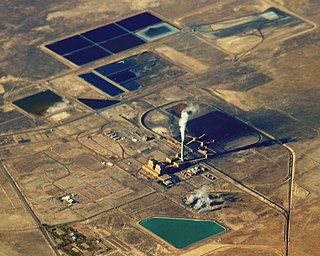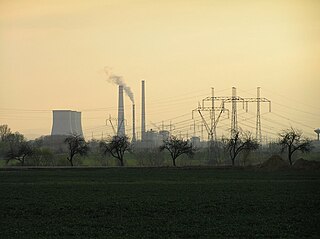Puget Sound Energy, Inc. (PSE) is an energy utility company based in the U.S. state of Washington that provides electrical power and natural gas to the Puget Sound region. The utility serves electricity to more than 1.2 million customers in Island, King, Kitsap, Kittitas, Pierce, Skagit, Thurston, and Whatcom counties, and provides natural gas to 877,000 customers in King, Kittitas, Lewis, Pierce, Snohomish and Thurston counties. The company's electric and natural gas service area spans 6,000 square miles (16,000 km2).

The electricity sector in Canada has played a significant role in the economic and political life of the country since the late 19th century. The sector is organized along provincial and territorial lines. In a majority of provinces, large government-owned integrated public utilities play a leading role in the generation, transmission, and distribution of electricity. Ontario and Alberta have created electricity markets in the last decade to increase investment and competition in this sector of the economy.

TransAlta Corporation is an electricity power generator and wholesale marketing company headquartered in Calgary, Alberta, Canada. It is a privately owned corporation and its shares are traded publicly. It operates 76 power plants in Canada, the United States, and Australia. TransAlta operates wind, hydro, natural gas, and coal power generation facilities. The company has been recognized for its leadership in sustainability by the Dow Jones Sustainability North America Index, the FTSE4Good Index, and the Jantzi Social Index. TransAlta is Canada's largest investor-owned renewable energy provider.

The Nanticoke Generating Station was a coal-fired power station in Nanticoke, Ontario in operation from 1972 to 2013. It was the largest coal power station in North America and, at full capacity, it could provide 3,964 MW of power into the southern Ontario power grid from its base in Nanticoke, Ontario, Canada, and provided as much as 15% of Ontario's electricity.

Orot Rabin is a power station located on the Mediterranean coast in Hadera, Israel which is owned and operated by the Israel Electric Corporation (IEC). As of 2022 it is Israel’s largest power station and contains six thermal generation units capable of producing a total of 2.59GW of electricity using coal as the primary fuel. In addition, under construction at the site are two single-shaft natural gas-powered combined-cycle units capable of generating 630 MW each. The older, unmodernised four of its total six coal-fuelled units will be closed by mid-2022 in order to eliminate this major source of air pollution in the country.

The Huntly Power Station is the largest thermal power station in New Zealand and is located in the town of Huntly in the Waikato. It is operated by Genesis Energy Limited, a publicly listed company. The station has five operational generating units – three 250 MW coal-and-gas-fired steam turbine units, a 50 MW gas peaking plant, and a 403 MW combined cycle gas turbine plant. The station also plays an important role in voltage support for the Northland, Auckland and Waikato regions.

Thunder Bay Generating Station is a defunct biomass-fired thermal power station owned by Ontario Power Generation ("OPG"). It is located on Mission Island in Thunder Bay, on the shore of Lake Superior.

The Lingan Generating Station is a 620 MW Canadian coal-fired electrical generating station located in the community of Lingan in Nova Scotia's Cape Breton Regional Municipality. Lingan is operated by Nova Scotia Power Inc. and is their largest generating station.

The Dickerson Generating Station is an 853 MW electric generating plant owned by NRG Energy, located approximately two miles west of Dickerson, Maryland, on the eastern banks of the Potomac River.

Little Barford Power Station is a combined cycle gas turbine power station in the village of Little Barford in Bedfordshire, England. It lies just south of the A428 St Neots bypass and east of the Wyboston Leisure Park. The River Great Ouse runs alongside. It was formerly the site of two coal-fired power stations, now demolished. The station is operated by RWE.
Coal reserves in Canada rank 13th largest in the world at approximately 10 billion tons, 0.6% of the world total. This represents more energy than all of the oil and gas in the country combined. The coal industry generates CDN$5 billion annually. Most of Canada's coal mining occurs in the West of the country. British Columbia operates 9 coal mines, Alberta nine, Saskatchewan three and New Brunswick one. Nova Scotia operates several small-scale mines, Westray having closed following the 1992 disaster there.

Brandon Generating Station is a natural gas-fired power station owned by Manitoba Hydro, located in Brandon, Manitoba, Canada. The station was first built to burn lignite from Saskatchewan.

Genesee Generating Station is a thermal power station owned by Capital Power Corporation, located near Genesee, Alberta, Canada; 71 km southwest of Edmonton, Alberta. The cooling pond covers 735 hectares. The pond is topped up with water from the North Saskatchewan River. As of June 18, 2024, all units are now 100% natural gas-fueled.
Keephills Generating Station is a coal fired station operated by TransAlta, located near Keephills, Alberta, Canada. Unit 3 is a low emission station, which replaced the older Wabamun 4 station.

Intermountain Power Plant is a large coal-fired power plant at Delta, Utah, US. It has an installed capacity of 1,900 MW, is owned by the Intermountain Power Agency, and is operated by the Los Angeles Department of Water and Power. The plant includes a HVDC converter. It is scheduled for replacement in 2025 with an 840 MW natural gas plant, designed to also burn "green hydrogen."

Łagisza Power Station is a coal-fired thermal power station at Łagisza in Będzin, Poland. The power plant has a total installed power capacity of 1,060 MW and installed cogeneration thermal capacity of 335 MW. It is operated by Południowy Koncern Energetyczny, a subsidiary of the Tauron Group.

Vojany Power Station was a thermal power station at Vojany, Slovakia. It consists of 12 units, with 110 MW generation capacity each. Planning of the first plant began in 1959, the project was approved in 1960, and construction began in 1961. It was commissioned in 1966. The second plant was approved in 1966, construction started in 1968, and it was commissioned in 1973–1974.
Island Generating Station is a natural gas-fired station owned by Capital Power Corporation, in Campbell River, British Columbia, Canada. The plant operates as a co-generation facility under a 20-year power purchase agreement with BC Hydro while steam is supplied to Elk Falls Mill.














